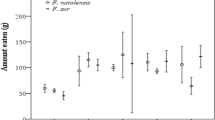Abstract
The fruits of the neem tree,Azadirachta indica A. Juss., are utilized in Senegal and elsewhere by man and numerous animals for food. Goats eat the seeds including the very bitter seed kernel. The sweet pulp is consumed by man and flying foxes (fruit bats), specially the straw-coloured flying fox,Eidolon helvum helvum (Kerr.). The same applies to some bird species, such as the v-marked or village weaver,Textor cucullatus (Müll.), the white vented bulbul,Pycnonotus barbatus (Desfont.), the long-tailed starling,Lamprotornis caudatus (Müll.), and otherLamprotornis spp., as well as to the mousebird,Urocolius macrourus (L.). All fruit-pulp eating animals are useful as they prepare the neem seeds for collection by man. This makes the labourious and time consuming process of depulping unnecessary, which is very important for the economic use of neem seeds for crop protection purposes, at least in W. Africa. On the other hand, goats may develop as important competitors of man if they consume large amounts of seeds in future.
Zusammenfassung
Die Früchte des NiembaumesAzadirachta indica werden in Senegal und anderswo durch mehrere Tierarten als Nahrung genutzt. Ziegen fressen die Samen einschließlich des sehr bitteren Samenkerns. Das süße Fruchtfleisch wird vom Menschen und von Flughunden, besonders dem PalmenflughundEidolon helvum helvum gegessen. Gleiches gilt für einige Vogelarten wie den DorfweberTextor cucullatus, den GraubülbülPycnonotus barbatus, den LangschwanzglanzstarLamprotornis caudatus und andereLamprotornis-Arten sowie für den MausvogelUrocolius macroursus. Alle fruchtfleischfressenden Tiere sind nützlich, da sie die Niemsamen für das Sammeln durch den Menschen vorbereiten. Dies macht den arbeits- und zeitaufwendigen Prozeß des Entpulpens überflüssig, was für die wirtschaftliche Anwendung von Niemsamen für Pflanzenschutzzwecke sehr wichtig ist, zumindest in Westafrika. Andererseits könnten sich Ziegen als wichtige Konkurrenten für den Menschen entwikkeln, wenn sie in Zukunft große Mengen an Niemsamen verzehren sollten.
Similar content being viewed by others
Literaturverzeichnis
Baumgart, M., 1991: Das Niemvorkommen in der Republik Benin. Unveröff. Bericht, GTZ Eschborn/Ts., 69 S.
Schmutterer, H., 1969: Pests of crops in Northeast and Central Africa. G. Fischer Verlag, Stuttgart, 296 S.
Schmutterer, H., 1990: Beobachtungen an Schädlingen vonAzadirachta indica (Niembaum) und von verschiedenen Melia-Arten. J. appl. Ent.109, 390–400.
Singh, R. V., 1982: Fodder trees of India. Oxford & IBH Publishing, New Delhi.
Benge, M. D., 1989: Cultivation and propagation of the neem tree. In:M. Jacobson (Ed.), 1988: Focus on phytochemical pesticides I, the neem tree (CRC press, Boca Raton, Fda.), 178 S.
Author information
Authors and Affiliations
Additional information
Mit einer Abbildung
Rights and permissions
About this article
Cite this article
Schmutterer, H. Beobachtungen über Nutznießer der Früchte des Niembaumes (Azadirachta indica) in Afrika mit besonderer Berücksichtigung von Senegal. Anz. Schadlingskde., Pflanzenschutz, Umweltschutz 65, 1–4 (1992). https://doi.org/10.1007/BF01905973
Issue Date:
DOI: https://doi.org/10.1007/BF01905973




